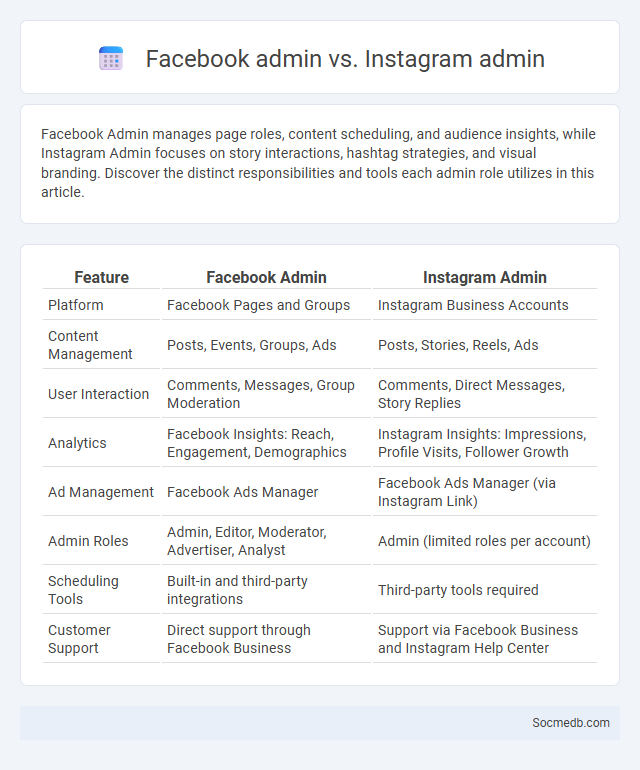
Photo illustration: Facebook Admin vs Instagram Admin
Facebook Admin manages page roles, content scheduling, and audience insights, while Instagram Admin focuses on story interactions, hashtag strategies, and visual branding. Discover the distinct responsibilities and tools each admin role utilizes in this article.
Table of Comparison
| Feature | Facebook Admin | Instagram Admin |
|---|---|---|
| Platform | Facebook Pages and Groups | Instagram Business Accounts |
| Content Management | Posts, Events, Groups, Ads | Posts, Stories, Reels, Ads |
| User Interaction | Comments, Messages, Group Moderation | Comments, Direct Messages, Story Replies |
| Analytics | Facebook Insights: Reach, Engagement, Demographics | Instagram Insights: Impressions, Profile Visits, Follower Growth |
| Ad Management | Facebook Ads Manager | Facebook Ads Manager (via Instagram Link) |
| Admin Roles | Admin, Editor, Moderator, Advertiser, Analyst | Admin (limited roles per account) |
| Scheduling Tools | Built-in and third-party integrations | Third-party tools required |
| Customer Support | Direct support through Facebook Business | Support via Facebook Business and Instagram Help Center |
Overview: Understanding the Role of an Admin
An admin on social media plays a crucial role in managing content, monitoring user interactions, and ensuring community guidelines are followed to maintain a positive online environment. Effective admin skills involve moderating posts, responding to user inquiries, and implementing strategies that enhance engagement and growth for your social media channels. Understanding these responsibilities helps maintain brand reputation and fosters a loyal audience on platforms like Facebook, Instagram, and Twitter.
Facebook Admin: Key Responsibilities and Features
Managing a Facebook page as an admin involves overseeing content creation, moderating comments, and analyzing engagement metrics to boost your audience's interaction. Key responsibilities include setting user roles, scheduling posts, and ensuring compliance with Facebook's community standards. You can leverage built-in tools like Insights and Creator Studio to optimize your social media strategy effectively.
Instagram Admin: Core Functions and Duties
Instagram admins manage content scheduling, user engagement, and account analytics to optimize reach and growth. They ensure community guidelines are followed while moderating comments and interactions to maintain a positive environment. Admins also coordinate with marketing teams to implement strategic campaigns and track performance metrics for continuous improvement.
General Admin: Definition and Scope Across Platforms
General Admin in social media encompasses the management of user accounts, content moderation, and platform settings to ensure smooth operation and compliance with community guidelines. It involves tasks such as overseeing access permissions, handling user reports, and implementing security protocols across various platforms like Facebook, Twitter, and Instagram. Your role in general admin helps maintain a safe, organized, and efficient social media environment tailored to each platform's unique features and user expectations.
Skills Required: Facebook Admin vs Instagram Admin
Facebook Admins require expertise in managing Facebook Pages, creating targeted ad campaigns, understanding Facebook Insights for data analytics, and moderating community interactions to maintain engagement and compliance with platform policies. Instagram Admins must be skilled in visual content curation, utilizing Instagram Stories and Reels for brand storytelling, leveraging Instagram Insights for audience behavior analysis, and managing hashtag strategies to boost organic reach. Both roles demand strong communication skills, proficiency in social media management tools, and the ability to adapt to platform-specific algorithm changes.
Platform Tools: Dashboard Comparison
Social media platform tools offer diverse dashboard features that enhance your content management and analytics capabilities, enabling streamlined monitoring and real-time engagement tracking. Comparing dashboards highlights differences in usability, customizable widgets, and data visualization, crucial for optimizing marketing strategies and improving audience insights. Selecting the right platform tool dashboard empowers your social media efforts with efficient scheduling, performance metrics, and integrated communication options.
Content Management: Strategies and Approaches
Effective social media content management involves planning, creating, scheduling, and analyzing posts to maximize engagement and reach. Utilizing data-driven strategies such as audience segmentation, content calendars, and A/B testing enhances your ability to deliver relevant and timely messages. By aligning your content approach with platform-specific algorithms and trends, you ensure consistent brand presence and measurable growth.
Audience Engagement: Facebook vs Instagram
Facebook's audience engagement excels through diverse content formats such as groups, live videos, and detailed event pages, encouraging active user interaction and community building. Instagram prioritizes visual storytelling with features like Stories, Reels, and interactive stickers, driving higher engagement rates among younger demographics through immersive, short-form content. Brands benefit from Facebook's robust targeting tools and Instagram's influencer partnerships to maximize reach and foster meaningful connections with their audiences.
Security and Access Controls for Admins
Effective security and access controls for social media admins are critical to preventing unauthorized access and maintaining platform integrity. Implementing multi-factor authentication, role-based permissions, and regular audit logs helps safeguard sensitive data and control administrative functions. Robust security protocols reduce the risk of account hijacking, data breaches, and unauthorized content manipulation on social media platforms.
Choosing the Right Admin Role for Your Needs
Selecting the appropriate admin role in social media management depends on the specific responsibilities and access levels required for effective page control. Roles such as Admin, Editor, Moderator, Advertiser, and Analyst provide varying permissions tailored to managing content, community engagement, advertising campaigns, and data insights. Understanding each role's capabilities ensures streamlined operations and enhances security by limiting access to sensitive information.
 socmedb.com
socmedb.com